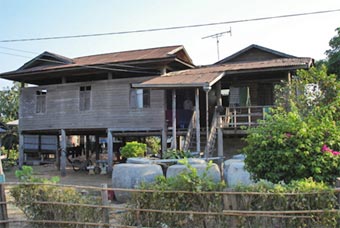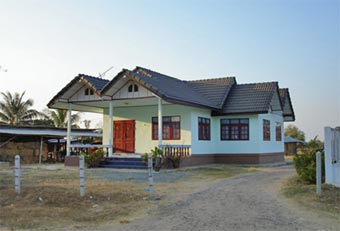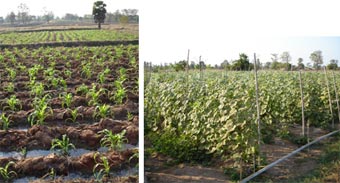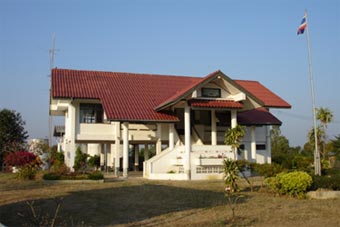My Isaan
After reading the submissions ‘A Visit to Isaan' by MM (Jan 16) and ‘Inaccurate Isaan' by Zaq1 (Jan 20), I thought I would share ‘my Isaan' with you. And I say ‘my' because that is exactly what this is:
my perception of the Isaan that I've come to know and love.
I hate Bangkok traffic and it's still a bit of a problem when we go to Isaan, at least as far as Rangsit. After that, I usually don't have to deal with much bad traffic. Of course, further along in my journey, I don't see a whole lot of
traffic at all except for those slow farm trucks, with the hand crank motors, usually quite colorful…. tuktuks. Anyway, back to my drive.
After passing Rangsit, the drive is pleasant enough. Just follow Highway 2 into Nakhon Ratchasima (a.k.a. Korat). One of the things I look forward to, if I make the trip during daylight hours, is the wonderful, white Buddha sitting on the side of the
mountain. But I usually make the trip pre-dawn or post-sunset. Chokchai Farm also looks nice and I've been meaning to stop there some time, if for no other reason than to try a burger or a steak. The trip to Korat, if driving straight through,
is about 3 hours. I used to make it in much less than that but I've started thinking more about conserving gas than shaving time off my drive. I'm not too sure why I care, though, because I don't actually pay for my gas.
I've only stopped in Korat a couple times. Once when visiting some of CG's family and once to grab a digital camera at The Mall. The price was more than I would have paid in Bangkok but it was a situation where I felt like I needed a camera
right then. Turns out I didn't (really) but I'd been meaning to buy one since I left my other one in the States on my last trip home.
From Korat, I head Northeast. Total trip time from Bangkok : 6 hours. Before long, the roads are lonely unless you pass one of the numerous active construction zones. There is a lot of road work going on and I can attest to the fact that it's needed.
Getting to CG's village feels like going to the end of the earth by the time I get there. It's not really so isolated, though. The town that I pass through 20 kilometers before reaching the village is on some Thailand maps that I've
seen. Just recently, they did a beautiful job of repairing the road leading from the town and heading in the direction of her village. They completely re-surfaced the road and did a wonderful job of it. The road leading into the village is paved
and it ends right in the heart of the community. The last kilometer of my drive is the most memorable. The surface is so bad that it's literally like a slalom course; you cannot drive a straight line. But the road crews are headed in that
direction so hopefully it will be repaired soon. From this road, you have dirt roads radiating off in all directions into the village. There has also been recent work performed on these roads. Some had rock laid down and others were graded.
The houses are a mixed lot. Most are houses that were built long ago when the village sprung up, no doubt. Take this example. This is a typical house (ban my) in the village.

It was built about 50 years ago and cost nothing more than the sweat of the owner and two of his friends. Ten children were raised in this home and never left the village. But time stands still for no one and there are changes taking place in the village.
So, what does a new house look like? It looks like this, pretty much, although there are variations:

Personally, I prefer the ‘ban my' style. Especially when it is on piers or stilts. In fact, what I prefer is ‘ban ruen Thai' and that's what I intend to build. But, back to the village. Even with
the new houses most still have separate bathroom facilities. It will either be a stand-alone cinder block structure or a small room on the rear of a cinder block house. If an old cinder block house still remains, family members may still be living
in it. Generally, there will be no hot water. No matter how many times I take a bath by pouring cold water over my body, I'll never get used to it. One improvement would have been to build the water basin along the exterior wall, instead
of the interior, to take advantage of heat transfer from the wall. Oh well, maybe next time. At CG's, they capture rainwater for drinking and use well water for everything else. The well does not seem to be contaminated and, when the bath
water is just pumped, is not that cold. But it's still colder than I like. In fact, my constant grousing about the water has led to CG affectionately referring to me as ‘baby thua yai'.
If you're going to make a living here, it will be on a farm. Otherwise, you need to head off to the big city. And that doesn't always mean Bangkok. Sometimes, many times, it doesn't even mean Thailand. In this village, they're just
as likely to leave the country in order to find work. And you can tell the ones that have done this when you look at the Western-influenced houses. Both CG and her father have been out of the country for work. Her sister works in Bangkok and,
as far as I know, has never left Thailand. She and her husband work at the same place. Sometimes she will stop working and go back home to help out. The land is parched/dry as has been observed but that doesn't mean you can't make a
living off it. It's just not an easy living. Crops do grow here. But, as can be seen in the photos, it helps to have a reliable means of getting/keeping water on hand. CG's father has dairy cattle, rice, pigs, mango, and some kind of
fish. When he didn't have time to bring in the rice, he had someone else do it in exchange for a percentage of the yield. The milk is his bread-and-butter. The mango and fish are not for sale. Initially, the fish were to be for sale but,
well, that just never happened.

Medical care, if needed, is readily available. The nearest clinic to CGs home is just a stone's throw away. And it is actually quite nice, too, but you judge for yourself:

There is another within 3 kilometers of the heart of the village and one within 10 kilometers. All of the clinics in this part of the world look more or less similar. Some are raised, as this one, above the ground while others are not but the style is
more or less the same. For all I know, it may be like this all across Thailand. As for hospitals, the nearest is 20 kilometers away. I also know of two others within another 10 kilometers. But, under the Thai health scheme, they are supposed to
use the one 20km from the village. The care given at the clinic in the village is quite good, given what care is provided. CG has mixed feelings about the hospital, though, because it is used for teaching. Are all government hospitals? The main
concern from this aspect seems to be related to cosmetic issues. Regardless, and there are teaching hospitals in every country, I think everyone would prefer to be getting care from an experienced medical practitioner rather than a student.
From what I see, the people of the village don't seem to know, or maybe just don't care, that others think they're neglected and missing out on the better things in life. To them, socializing with their family/friends is all important.
They generally seem to be happy and it's rare to see anyone by themselves. If you find yourself in need of a helping hand, you'll usually find more than one reaching out to help you, unlike in the big city. As CG explained to me, help
(whether to family or friend) is extended to those in need and it's taken on faith that a hand will be there for you when you need it. Someone said, in one submission on this site, that it was written into Thai law that the daughters were
legally bound to help the family. True or not? I don't know but CG just laughed at this. She said there are basically two reasons for helping the family: (1) you are repaying them for what they have done for you and (2) you are setting a
good example for the next generation (your children) who you hope will be there to help you when you really need it.
So, what is there for the farang who hikes out to the middle of nowhere? Not a lot but, fortunately, I don't need a lot. Even in the States, I moved from the city to a rural area to escape the rat race. I have enough of whatever outside stimulation/interaction
I might need from work. After work, all I want to do is escape. And Isaan fits the bill rather nicely. Granted, you will have a better time if you learn the language and I'll be the first to admit that I've been remiss on this point.
Initially I did want to learn it but I've found that I have enough with the limited ability I've attained and so I have no great motivation to spend a lot of time on it. CG still teaches me things each day (some of which I remember and
some I forget) and I teach her a little more English. I know that I will live my life in the States (or bouncing around the globe for work for the foreseeable future) so I don't find learning Thai to be of any great significance in my life.
Sure, there are times I wish I knew more but I know my time here is limited. To stay for an extended period of longer than a year or two at a time, I'd have to go on local contract and I don't find that prospect overly appealing at this
point. But, what I do like, and what I've not bored of, no matter how many times I go or how long I stay, is saying goodbye to Bangkok and heading back to the farm every chance I get. The people in Bangkok may look down on those from Isaan
(or other rural areas) but these are exactly the people I prefer to spend my time with. As with anything, there are always exceptions, but the rural folks are the ones that give me the Thailand I love. This is not limited to Isaan, either. My
first exposure to rural areas in Thailand was to the south of Bangkok but not so far south as to have the experience spoiled by the problems in the deep South.
There is one thing in the village that causes mixed emotions. One day, there was a caged truck driving around and something was being said over a loud speaker. I didn't understand it and didn't think much of it because I see this all the time.
Only this one was different and it took a moment to realize it. Instead of the normal peddlers, which is what I expected this to be, this one was rounding up unwanted dogs. Ok, so we have the same thing in the States, sort of. Unwanted dogs are
rounded up and given food/shelter for a ‘generous' three days before they are euthanized unless they are lucky enough to be adopted. And, unless they're puppies, they have about a snowballs chance in hell. I doubt these in Isaan
had the three days because they were destined for someone's table. A lot of the strays and soi dogs in Bangkok look like you would be doing them a favor if you euthanized them but the dogs in the villages are different. They are usually fed
well enough and generally don't look so mangy. And I'd have to be starved half to death before I could even remotely consider eating a dog.
Stickman's thoughts:
Yep, life in the villages of Isaan is very different to Farangland. Anyone with a real interest in the region will find that the locals are generally very welcoming, and hospitable, notwithstanding that very few comforts exist in bona fide typical villages.




